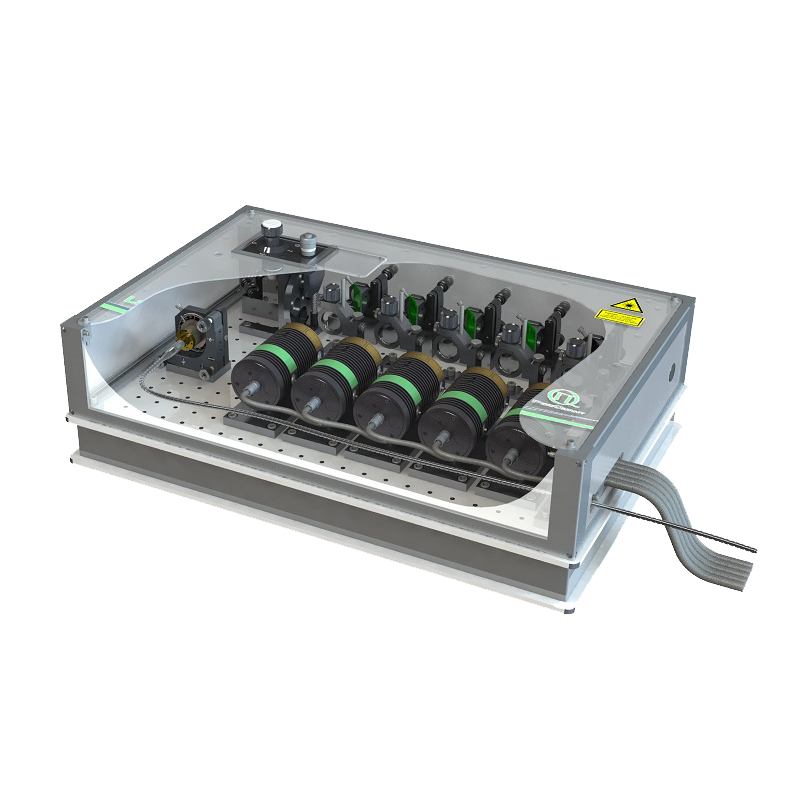Flexible Laser Combining Unit for up to 5 Laser Lines
Features:
- Wavelength 375 nm to 900 nm
- Up to 5 laser lines
- Polarisation maintaining singlemode output fibre
- Flexible configurations
- Supports laser heads of the LDH Series and LDH-FA Series
Applications:
- Time-Resolved Fluorescence
- Pulsed Interleaved Excitation (PIE)
- Dual Focus Fluorescence Correlation Spectroscopy (2fFCS)
- Fluorescence Lifetime Imaging (FLIM)
- Fluorescence Correlation Spectroscopy (FCS)
- Fluorescence Lifetime Correlation Spectroscopy (FLCS)
- Foerster Resonance Energy Transfer (FRET)
- Stimulated Emission Depletion Microscopy (STED)
- Fluorescence Anisotropy (Polarisation)
- TRPL Imaging
- Antibunching
- Single Molecule Spectroscopy
The Laser Combining Unit (LCU) is a flexible platform that allows combining the optical output of up to 5 laser heads of the LDH Series and the LDH-FA Series into a polarisation maintaining single mode fibre. When used in conjunction with the multichannel laser driver PDL 828 “Sepia II”, the LCU provides a convenient and easy-to-use solution for realising all manner of multi-colour excitation patterns. These patterns with varying degree of sophistication are the basis for a broad range of applications such as dual-focus time-resolved FCS, Pulsed Interleaved Excitation (PIE), duty-cycle optimised PIE, pump-probe measurements, and STED microscopy.

One housing, outstanding flexibility
The LCU‘s open architecture provides outstanding flexibility in terms of wavelength combination. The individual laser beams are combined using dichroic mirrors, which makes wavelengths changes and additions to an existing LCU configuration possible on-site. A scaffold in combination with a ND filter wheel permit a manual adjustment of the power of the combined laser beams before they are coupled into a polarisation maintaining single mode fibre. This allows a smooth adjustment of output power and facilitates the integration of the laser heads into existing set-ups. Nearly every laser head from the LDH Series and LDH-FA Series can be integrated into the LCU, offering a choice of discreet wavelengths ranging from 375 nm to 900 nm. Even external lasers can be combined with the laser heads inside the LCU via a fibre adapter. In that way it is possible to combine high-power UV or blue laser heads with a tunable supercontinuum laser covering the visible and NIR spectral range. Adding or exchanging laser heads in the LCU can be easily done on-site and the LCU‘s design make routine adjustments a simple task.

Complex pulse patterns at your fingertips with the Sepia PDL 828
Each laser head integrated into the LCU can be controlled either individually or in combination with any other head thanks to the powerful oscillator module of the PDL 828 “Sepia II” driver. Laser heads from the LDH Series or LDH-FA Series can be operated in pulsed, burst, or continuous wave (selected models only) mode. The 8 channel oscillator module allows generating virtually unlimited pulse patterns where multiple laser sources can emit pulses simultaneously, sequentially, or in combination with any other laser. The pulses from each laser head can easily be temporally moved with respect to the others with an accuracy down to the ps range thanks to the delayer provided by the PLD 828 “Sepia II” driver, which is invaluable for STED microscopy. The oscillator module of the PDL 828 “Sepia II” supports control for up to 8 lasers, meaning that 3 external lasers (such as the high power depletion laser VisIR-765-HP “STED” or the multiple UV line laser VisUV) can be synchronised with the LCU‘s 5 integrated lasers.







































